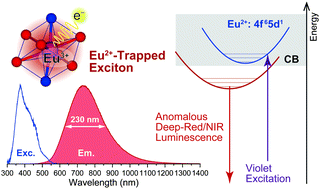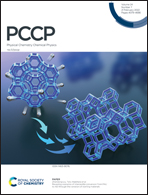Deep-red to near-infrared luminescence from Eu2+-trapped exciton states in YSiO2N†
Abstract
The valence state of Eu ions doped in inorganic compounds is easily influenced by the synthesizing conditions. In this study, X-ray absorption spectroscopy revealed that almost half of Eu ions incorporated in the YSiO2N host were reduced into the divalent state through the sintering process at 1600 °C under a N2 gas atmosphere without any annealing processes. The prepared Eu2+/3+-doped YSiO2N sample showed anomalous deep-red to near-infrared luminescence below 300 K under violet light illumination, whose luminescent properties are discussed through detailed spectroscopic analyses. In the photoluminescence spectra at 4 K, the broad luminescence band ranging from 550 to 1100 nm with a large Stokes shift of 5677 cm−1 was observed, assigned to the recombination emission related to the Eu2+-trapped exciton state. The temperature dependence of luminescence lifetime suggests that the thermal quenching of Eu2+-trapped exciton luminescence takes place through complicated processes in addition to thermal ionization. The energy diagrams based on the spectroscopic results indicate that Eu2+-trapped exciton luminescence in the YSiO2N:Eu2+/3+ sample was observed because all the Eu2+: 5d excited levels are degenerated with the host conduction band, and the relatively stable Eu2+-trapped exciton state in the Y3+ sites is formed just below the conduction band bottom. A comprehensive discussion on the deep-red to near-infrared luminescence in the YSiO2N host could give new insights into the mechanism of Eu2+-trapped exciton luminescence in Y3+ sites, which has potential in near-infrared emitting devices.



 Please wait while we load your content...
Please wait while we load your content...